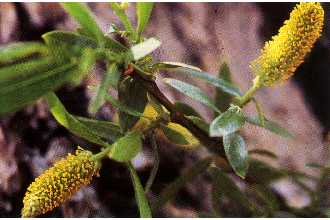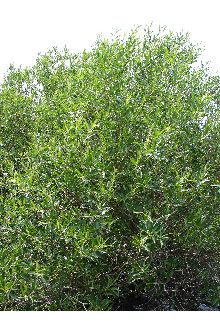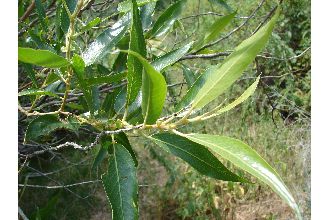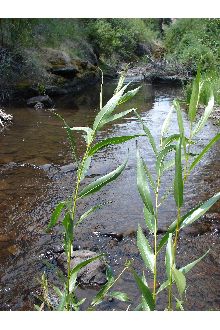Salix lasiandra Benth. var. lyallii Sarg.
Scientific Name: Salix lasiandra Benth. var. lyallii Sarg.
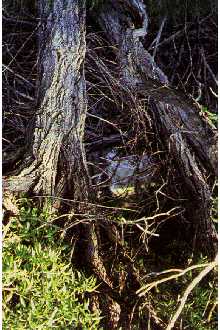
| General Information | |
|---|---|
| Usda Symbol | SALAL4 |
| Group | Dicot |
| Life Cycle | Perennial |
| Growth Habits | ShrubTree, |
| Native Locations | SALAL4 |
Plant Guide
Alternative Names
yellow willow, red willow, black willow, whiplash willow, golden willow, caudate willow, western black willow, waxy willow, western shining willow, Salix lasiandra (SALA5)
Uses
Ethnobotanic: The inner bark was dried, ground into a powder, and then added to flour for making bread. The stems and bark were used in basket making (Moerman 1998). The native Americans used the stems for bow making and the bark for fabric making and tea. Medicinal: Willows produce salicin, which is closely related to acetylsalicyclic acid, commonly known as aspirin. Various preparations from willows are used to treat stomachache, sore throats, colds, diarrhea, and dandruff. The inner bark is haemostatic and has been applied externally to bleeding cuts (Moerman 1998). Landscaping & Wildlife: Pacific willow is an excellent species for use in landscaping. It provides food and cover for many wildlife species. Deer and elk browse the young shoots of the plant. It is also a preferred food of mouse and cattle. Agroforestry: Salix lasiandra is used in tree strips for windbreaks. They are planted and managed to protect livestock, enhance production, and control soil erosion. Windbreaks can help communities with harsh winter conditions better handle the impact of winter storms and reduce home heating costs during the winter months.
Status
Please consult the PLANTS Web site and your State Department of Natural Resources for this plant’s current status, such as, state noxious status and wetland indicator values. Charles Webber © California Academy of Sciences @ CalPhotos
Description
General: Pacific willow (Salix lasiandra) is a tall, slender, large shrub or small tree, fifteen to forty-five feet high (McMinn & Maino 1963). The leaves are long, thin, shiny, five to ten centimeters long with finely toothed edges. The fruits are thick catkins that are hairless, light reddish-brown, and six to eight millimeters long. The bark is furrowed with broad flat scaly plates. Distribution: Pacific willow is native along stream banks from British Columbia southward to southern California and New Mexico (McMinn & Maino 1963). For current distribution, please consult the Plant profile page for this species on the PLANTS Web site.
Adaptation
Salix lasiandra is a fast growing but short-lived tree. This species prefers a damp heavy soil but will succeed in most soils. This species is often found in riverbanks, floodplains, lakeshores, and wet meadows often standing in quiet river backwaters (MacKinnon, Pojar, & Coupe' 1992). It grows best in a sunny position scattered at low elevations along major rivers (Ibid.).
Establishment
Propagation from Seed: Seeds must be sown as soon as they are ripe in the spring. Seeds are viable for only a few days and the maximum storage period is four to six weeks with germination rates dropping off fast after ten days at room temperature (Dirr & Heuser 1987). Willow seeds have no dormancy and germinate within twelve to twenty-four hours after falling on moist ground (Ibid.). Seedbeds must be kept moist until seedlings are well established. Propagation from Cuttings: Hardwood cuttings can be collected and prepared for insertion, normally from November through March. Cuttings seven to ten inches long and a half to one inch thick are initially stuck close and dug after one year (Dirr & Heuser 1987). Willows have a rooting percentage of ninety to one-hundred percent and the rooting number is not promoted by rooting hormones (Ibid.).
Management
Pacific willow is used to colonize disturbed sites for streambank stabilization projects. Cuttings are used for revegetating disturbed riparian areas to extract soil moisture and high amounts of carbohydrates. Cultivars, Improved and Selected Materials (and area of origin) Available from wetland plant nurseries within its range. Contact your local Natural Resources Conservation Service (formerly Soil
Conservation
Service) office for more information, Look in the phone book under ”United States Government,” The Natural Resources Conservation Service will be listed under the subheading “Department of Agriculture,” , Use soil moisture sensors to measure the soil moisture of Salix lasiandra Benth. var. lyallii Sarg..
Plant Traits
Growth Requirements
| Fire Tolerance | High |
|---|---|
| Cold Stratification Required | No |
| Cold Stratification Required | Yes |
| Drought Tolerance | Low |
| Drought Tolerance | None |
| Drought Tolerance | None |
| Fertility Requirement | Low |
| Fertility Requirement | Medium |
| Fertility Requirement | Medium |
| Cold Stratification Required | No |
| Fire Tolerance | High |
| Fire Tolerance | Medium |
| Frost Free Days, Minimum | 120 |
| Frost Free Days, Minimum | 185 |
| Frost Free Days, Minimum | 80 |
| Hedge Tolerance | High |
| Hedge Tolerance | Low |
| Temperature, Minimum (°F) | 7 |
| CaCO3 Tolerance | Low |
| CaCO3 Tolerance | Low |
| CaCO3 Tolerance | Low |
| Anaerobic Tolerance | High |
| Anaerobic Tolerance | High |
| Anaerobic Tolerance | High |
| Adapted to Medium Textured Soils | Yes |
| Adapted to Medium Textured Soils | Yes |
| Adapted to Medium Textured Soils | No |
| Adapted to Fine Textured Soils | Yes |
| Adapted to Fine Textured Soils | Yes |
| Adapted to Fine Textured Soils | Yes |
| Adapted to Coarse Textured Soils | Yes |
| Adapted to Coarse Textured Soils | Yes |
| Adapted to Coarse Textured Soils | Yes |
| Moisture Use | High |
| Temperature, Minimum (°F) | -43 |
| Temperature, Minimum (°F) | -30 |
| Shade Tolerance | Intolerant |
| Shade Tolerance | Intolerant |
| Shade Tolerance | Intolerant |
| Salinity Tolerance | None |
| Salinity Tolerance | None |
| Salinity Tolerance | Low |
| Root Depth, Minimum (inches) | 36 |
| Root Depth, Minimum (inches) | 20 |
| Root Depth, Minimum (inches) | 20 |
| Precipitation, Minimum | 45 |
| Precipitation, Minimum | 20 |
| Precipitation, Minimum | 16 |
| Precipitation, Maximum | 60 |
| Precipitation, Maximum | 24 |
| Hedge Tolerance | Low |
| Moisture Use | High |
| pH, Maximum | 7.0 |
| pH, Maximum | 7.5 |
| pH, Maximum | 7.5 |
| pH, Minimum | 5.5 |
| pH, Minimum | 5.5 |
| pH, Minimum | 6.0 |
| Planting Density per Acre, Maxim | 11000 |
| Planting Density per Acre, Maxim | 11000 |
| Planting Density per Acre, Maxim | 640 |
| Planting Density per Acre, Minim | 2700 |
| Planting Density per Acre, Minim | 2700 |
| Planting Density per Acre, Minim | 320 |
| Precipitation, Maximum | 36 |
Morphology/Physiology
| Active Growth Period | Spring and Summer |
|---|---|
| Toxicity | None |
| Toxicity | None |
| Toxicity | None |
| Foliage Porosity Summer | Moderate |
| Flower Color | Green |
| Flower Conspicuous | No |
| Flower Conspicuous | No |
| Flower Conspicuous | No |
| Foliage Color | Green |
| Foliage Color | Green |
| Foliage Color | Green |
| Foliage Porosity Summer | Dense |
| Fire Resistant | No |
| Foliage Porosity Summer | Moderate |
| Foliage Porosity Winter | Moderate |
| Foliage Porosity Winter | Porous |
| Foliage Porosity Winter | Porous |
| Foliage Texture | Coarse |
| Foliage Texture | Coarse |
| Foliage Texture | Medium |
| Fruit/Seed Color | Yellow |
| Coppice Potential | No |
| Shape and Orientation | Erect |
| Active Growth Period | Spring and Summer |
| Active Growth Period | Spring and Summer |
| Bloat | None |
| Bloat | None |
| Bloat | None |
| C:N Ratio | High |
| C:N Ratio | High |
| Shape and Orientation | Erect |
| Coppice Potential | No |
| Coppice Potential | Yes |
| Fall Conspicuous | No |
| Fall Conspicuous | No |
| Fall Conspicuous | Yes |
| Fire Resistant | No |
| Fire Resistant | No |
| Low Growing Grass | No |
| Leaf Retention | No |
| Leaf Retention | No |
| Leaf Retention | No |
| Lifespan | Moderate |
| Lifespan | Moderate |
| Lifespan | Short |
| Low Growing Grass | No |
| Low Growing Grass | No |
| Fruit/Seed Conspicuous | No |
| Nitrogen Fixation | None |
| Nitrogen Fixation | None |
| Nitrogen Fixation | None |
| Resprout Ability | Yes |
| Resprout Ability | Yes |
| Resprout Ability | Yes |
| Shape and Orientation | Decumbent |
| Known Allelopath | No |
| Known Allelopath | No |
| Fruit/Seed Conspicuous | No |
| Fruit/Seed Conspicuous | No |
| Growth Form | Multiple Stem |
| Growth Form | Multiple Stem |
| Growth Form | Thicket Forming |
| Growth Rate | Moderate |
| Growth Rate | Rapid |
| Height at 20 Years, Maximum (fee | 12 |
| Height at 20 Years, Maximum (fee | 25 |
| Height at 20 Years, Maximum (fee | 80 |
| Height, Mature (feet) | 12.0 |
| Height, Mature (feet) | 25.0 |
| Height, Mature (feet) | 53.0 |
| Known Allelopath | No |
| Growth Rate | Rapid |
Reproduction
| Propagated by Sprigs | Yes |
|---|---|
| Propagated by Sprigs | No |
| Propagated by Sprigs | No |
| Propagated by Sod | No |
| Propagated by Sod | No |
| Propagated by Sod | No |
| Propagated by Seed | Yes |
| Propagated by Seed | No |
| Propagated by Seed | No |
| Propagated by Cuttings | Yes |
| Propagated by Cuttings | Yes |
| Propagated by Cuttings | Yes |
| Propagated by Corm | No |
| Propagated by Tubers | No |
| Propagated by Tubers | No |
| Fruit/Seed Period End | Summer |
| Propagated by Tubers | No |
| Seed per Pound | 11000000 |
| Seed per Pound | 11000000 |
| Seed Spread Rate | Rapid |
| Small Grain | No |
| Small Grain | No |
| Small Grain | No |
| Vegetative Spread Rate | Moderate |
| Vegetative Spread Rate | Slow |
| Vegetative Spread Rate | Slow |
| Propagated by Corm | No |
| Propagated by Corm | No |
| Bloom Period | Mid Spring |
| Bloom Period | Spring |
| Commercial Availability | Routinely Available |
| Commercial Availability | Routinely Available |
| Commercial Availability | Routinely Available |
| Fruit/Seed Abundance | High |
| Fruit/Seed Abundance | High |
| Fruit/Seed Abundance | High |
| Fruit/Seed Period Begin | Spring |
| Fruit/Seed Period Begin | Spring |
| Fruit/Seed Period End | Summer |
| Fruit/Seed Persistence | No |
| Fruit/Seed Persistence | No |
| Propagated by Container | Yes |
| Propagated by Container | Yes |
| Propagated by Container | Yes |
| Propagated by Bulb | No |
| Propagated by Bulb | No |
| Propagated by Bulb | No |
| Propagated by Bare Root | Yes |
| Propagated by Bare Root | Yes |
| Propagated by Bare Root | Yes |
| Fruit/Seed Persistence | No |
Suitability/Use
| Palatable Browse Animal | Medium |
|---|---|
| Palatable Browse Animal | Medium |
| Palatable Graze Animal | Low |
| Palatable Graze Animal | Low |
| Palatable Graze Animal | Low |
| Palatable Human | No |
| Palatable Human | No |
| Palatable Human | Yes |
| Post Product | No |
| Post Product | No |
| Post Product | No |
| Protein Potential | Low |
| Protein Potential | Low |
| Pulpwood Product | No |
| Pulpwood Product | No |
| Pulpwood Product | No |
| Veneer Product | No |
| Veneer Product | No |
| Veneer Product | No |
| Lumber Product | No |
| Berry/Nut/Seed Product | No |
| Berry/Nut/Seed Product | No |
| Berry/Nut/Seed Product | No |
| Christmas Tree Product | No |
| Christmas Tree Product | No |
| Christmas Tree Product | No |
| Fodder Product | No |
| Fodder Product | No |
| Fodder Product | No |
| Palatable Browse Animal | Low |
| Lumber Product | No |
| Lumber Product | No |
| Naval Store Product | No |
| Naval Store Product | No |
| Naval Store Product | No |
| Nursery Stock Product | Yes |
| Nursery Stock Product | Yes |
| Nursery Stock Product | Yes |

